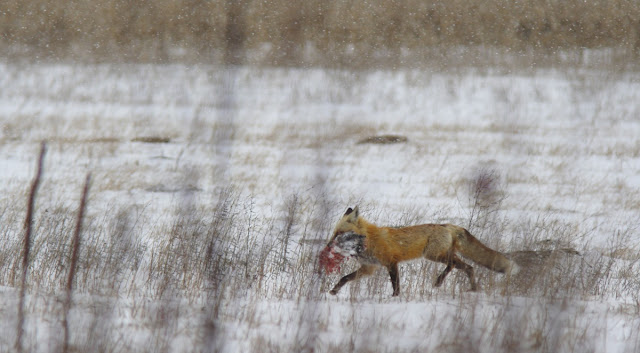Back to the Bog 23 February 2013
Home range, for most animals, is different than
territory. Territories are defended,
sometimes with great hostility, but home range is a wider span. Home range is a land of wandering and exploring
that an animal comes to know well. Home
range is not restricted to the core of the animal’s life. As large mammals, humans are peculiar in
territory and home range. We are more
like birds.
Evening Grosbeaks
Common Redpoll
Boreal Chickadee
Gray Jay
We travel in social groups, our home ranges overlap
significantly, but we retire to our small dwellings, homes we defend vigorously
and seldom invite others into. Our
nesting territories are tiny in comparison to our home ranges, and there is
significant overlap in the places we seek our favorite resources. Like flocks of waxwings and winter finches, birders and photographers sometimes migrate for the
good stuff, congregating together to feed up on a temporary treasure. We tolerate each other in large groups, we
respect each other, and we enjoy each other, laughing, sharing, learning, and
building our flock. It isn't perfect, but it works.
Brown Creeper
Bald Eagle
Wildlife photographers are usually less like humans, less
like birds, and more like wolves. If birds at all, we are more like eagles and less like social flocks of finches, more like camouflaged certhids, scouting and probing things out alone. We
hold more territorial turf in our home ranges, jealously guarding the secrets that help us
make art. We spend countless hours scouting and roaming the back wilds and
undiscovered wildlife. We are usually alone or in a small pack. But we cannot escape our own humanity. There are times we flock together with great
joy. And there are some who are so generous, so giving of their secrets, that the rest of us can migrate long distances and land with certainty
within a few feet of a rare Boreal Chickadee or a Hoary Redpoll. These generous people are scouts and artists who freely invite others to feast from their own territories. We treasure them greatly.
Hoary Redpoll
Common Redpoll
I once cheered aloud when Steve Martin uttered three
special words in the movie, “The Big Year.”
He said, “Sax Zim Bog”. Maybe it
was Owen Wilson, or maybe it was Jack
Black uttering the magic phrase. Whatever the case, a celebrity
read a line that spoke of a place I know and love. It is a place where I was once a wolf, a
loner in a lonely wilderness. It is now
a treasured destination for thousands of birdwatchers.
Brown Creeper
Boreal Chickadee
The etiquette has change a lot in 20 years. Birders politely follow ABA protocol and keep
the opportunities for others alive and well.
It is less thigh deep snow, less bitter cold challenge, and far more certain. Thanks to some very dedicated birders, the
bog now has permanent feeding stations that draw rare birds to plain view. Less
work, less solitude, more birds. It is a
social experience now, and, while vastly different from what I once knew, I’ll
gladly take it.
Great Gray Owl
Admiral
Road, Owl Avenue, Spruce Road, and other rustic, gravel road places among the
bog trees make for some outstanding wildlife photography, birding, and nature
observation. All images were made with a
refurbished Canon 7D and my usual Canon 300 f4L IS lens. The day began and ended along the North Shore
of Lake Superior. As the season draws
dangerously close to the end, I can say with a smile that this has certainly
been a REAL Winter!
























































